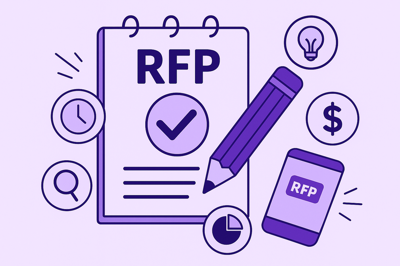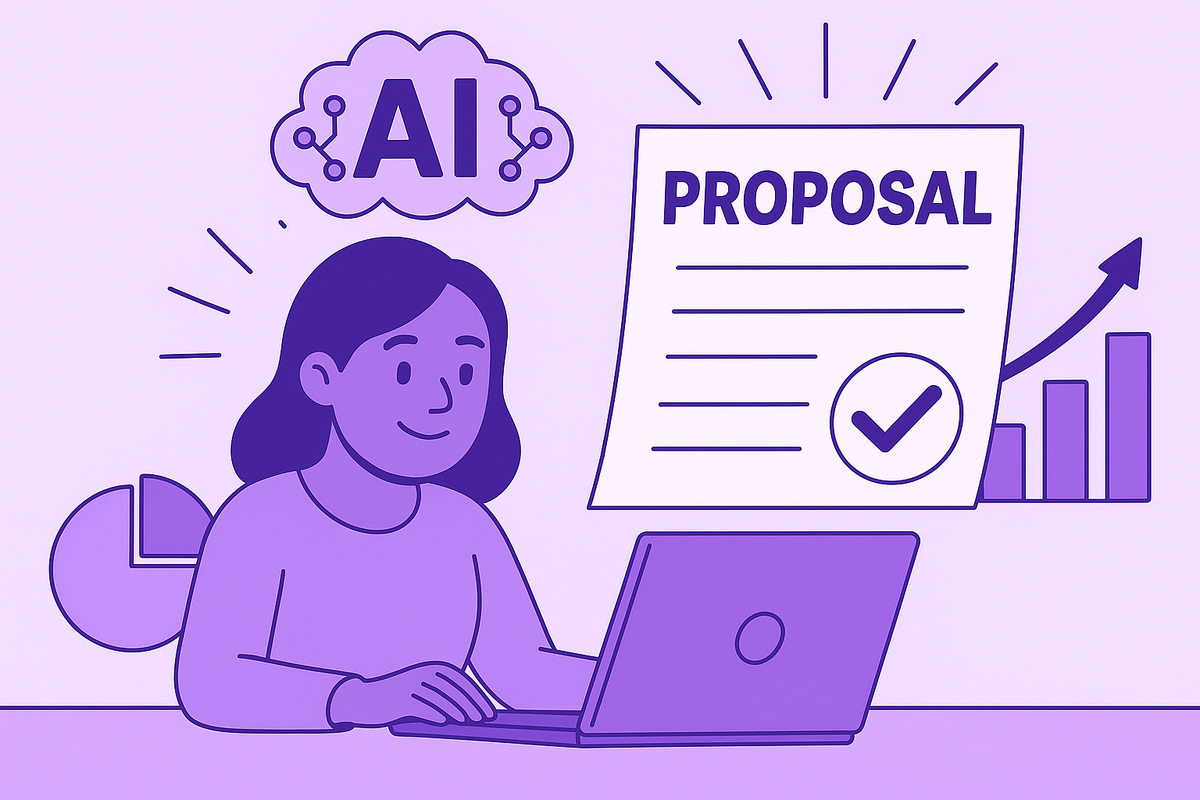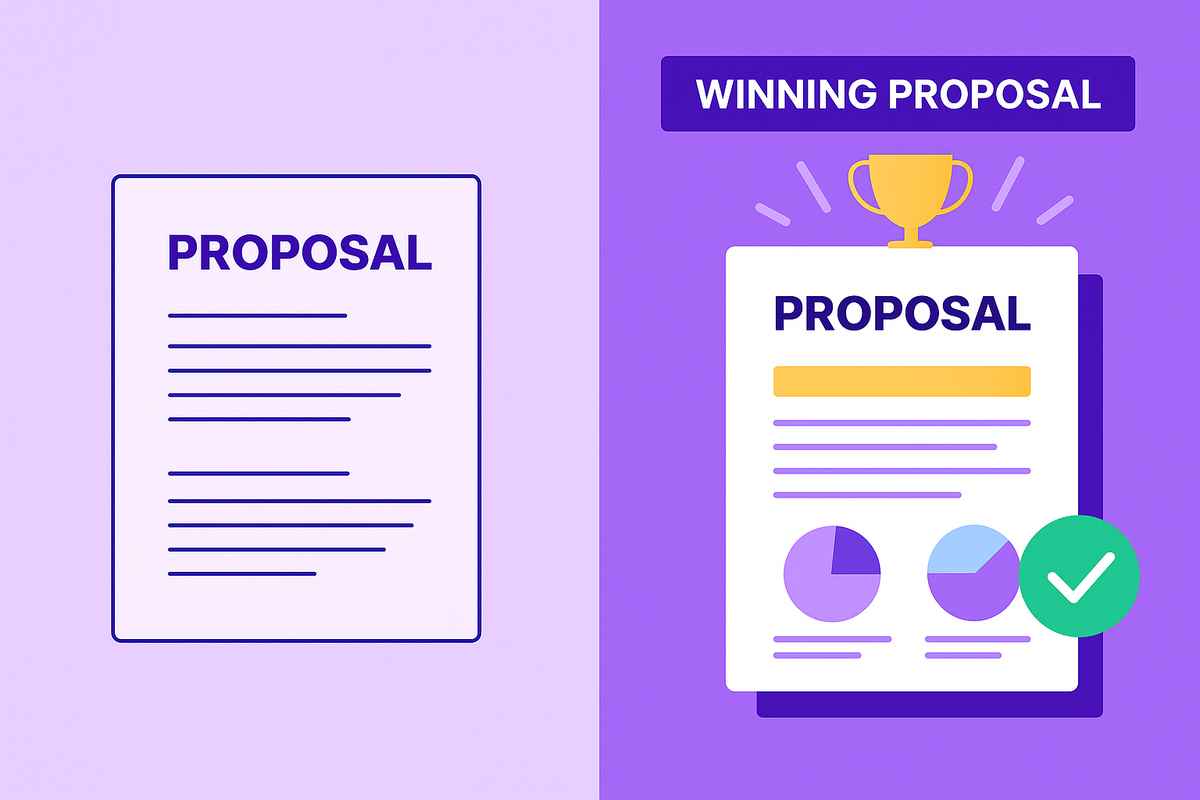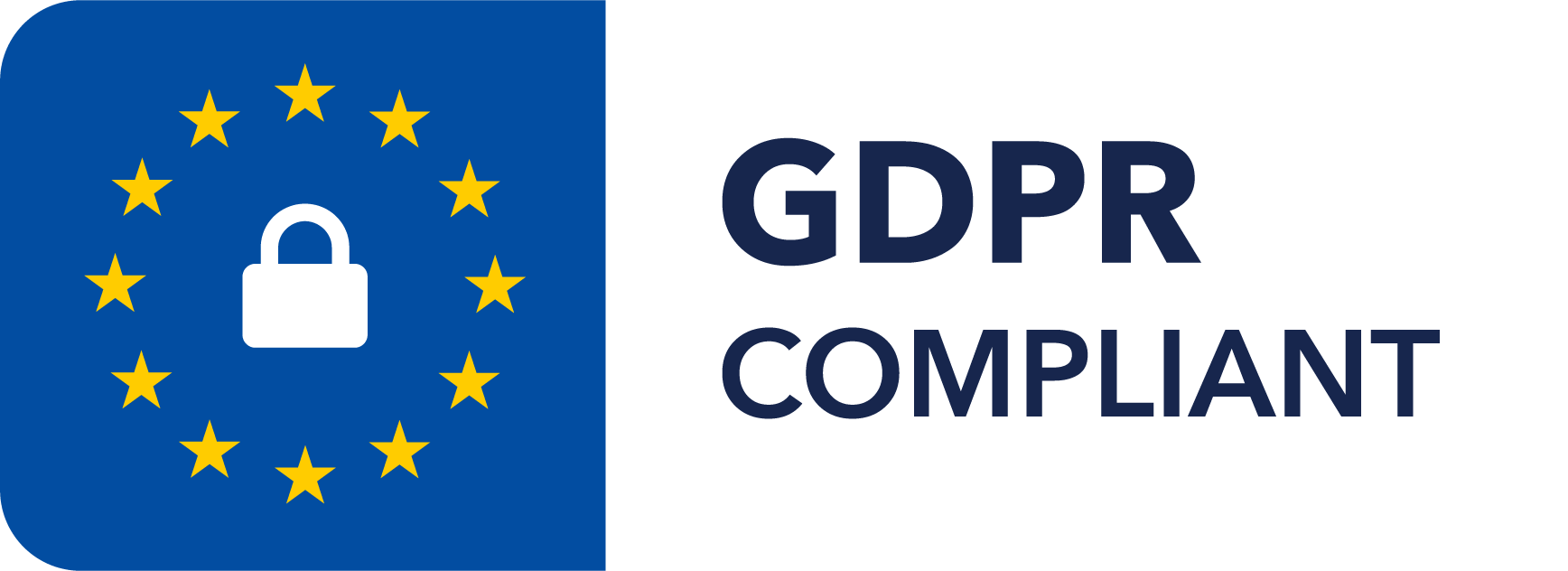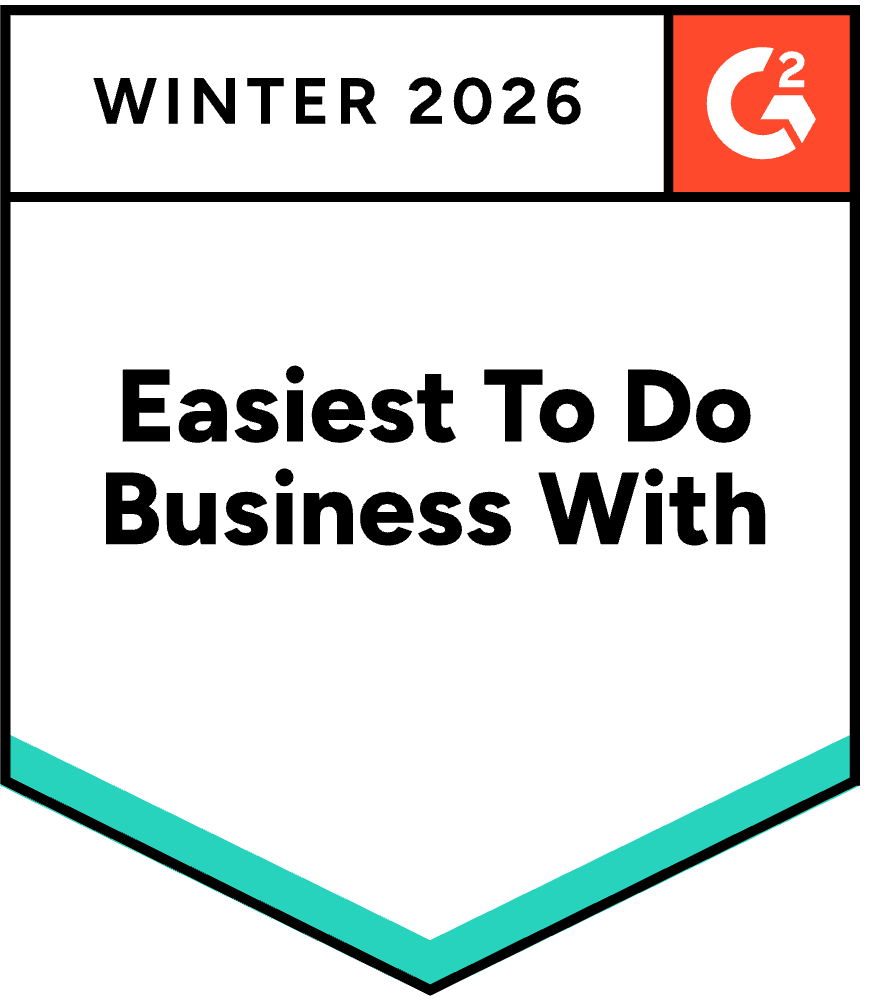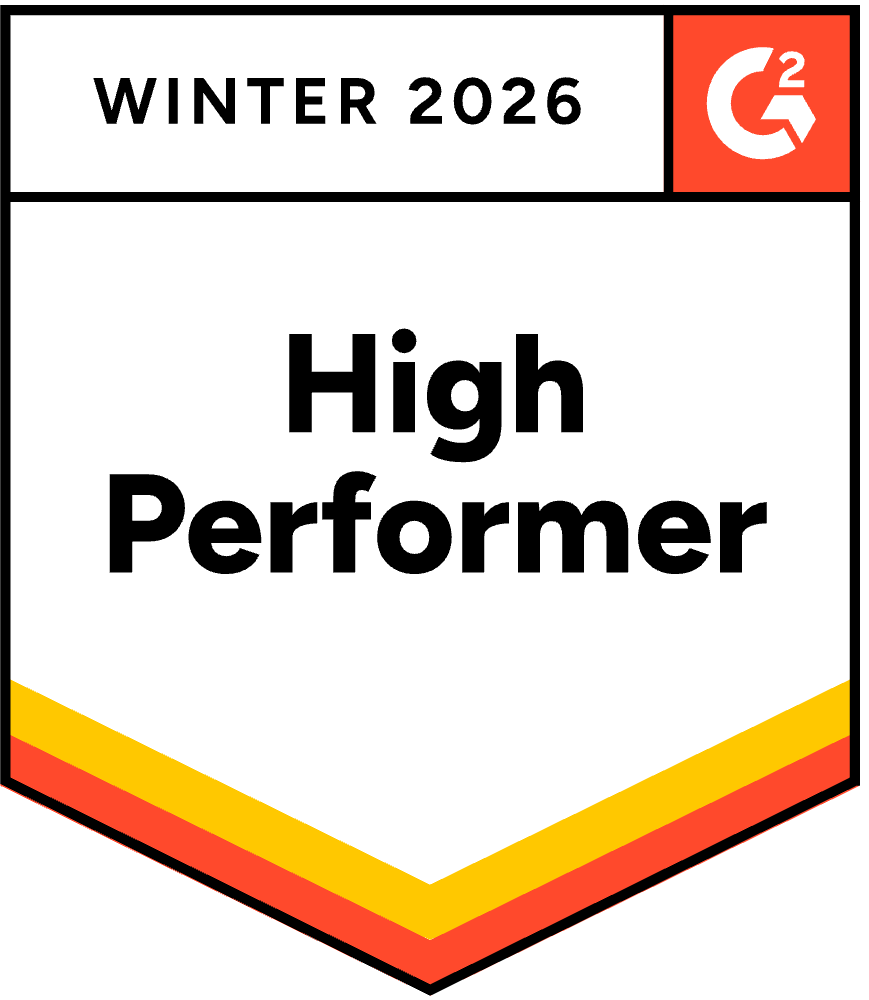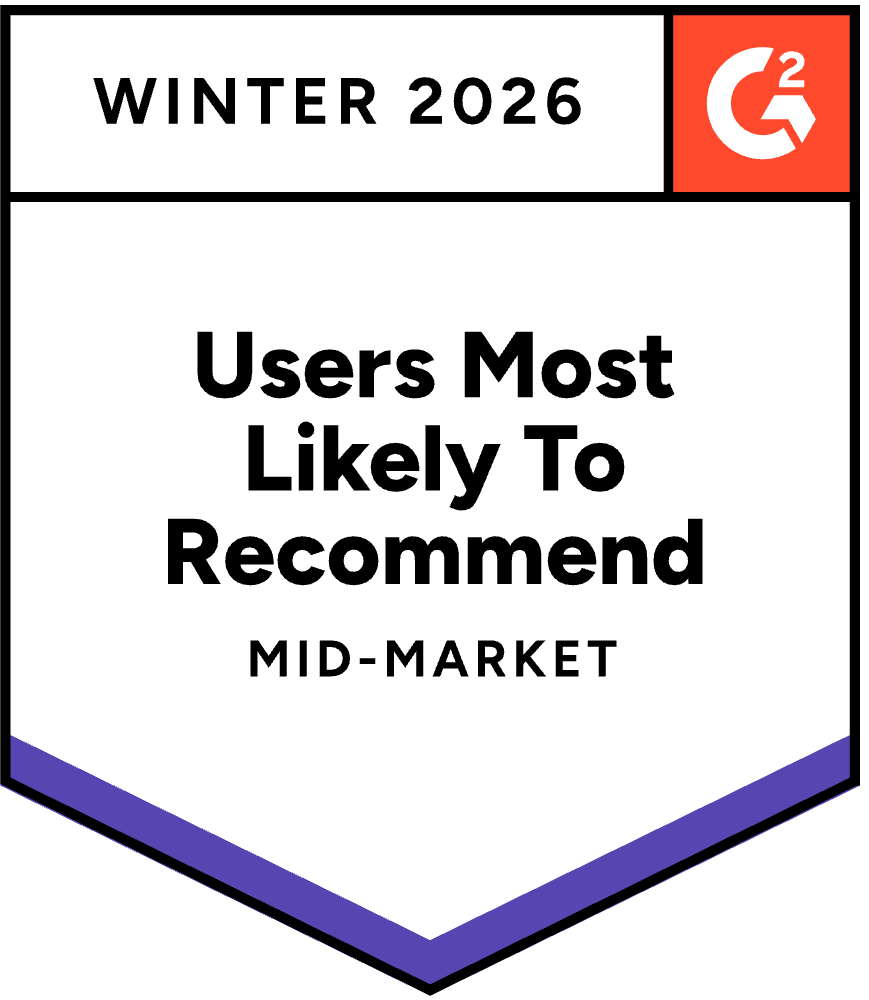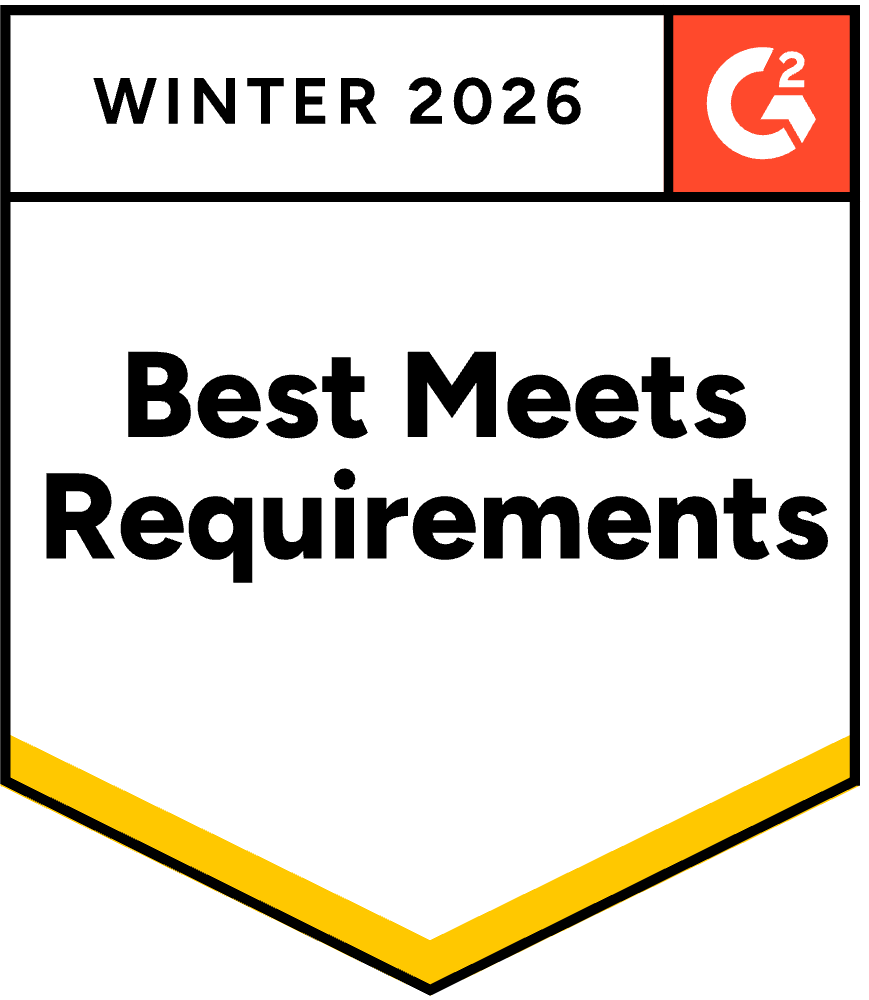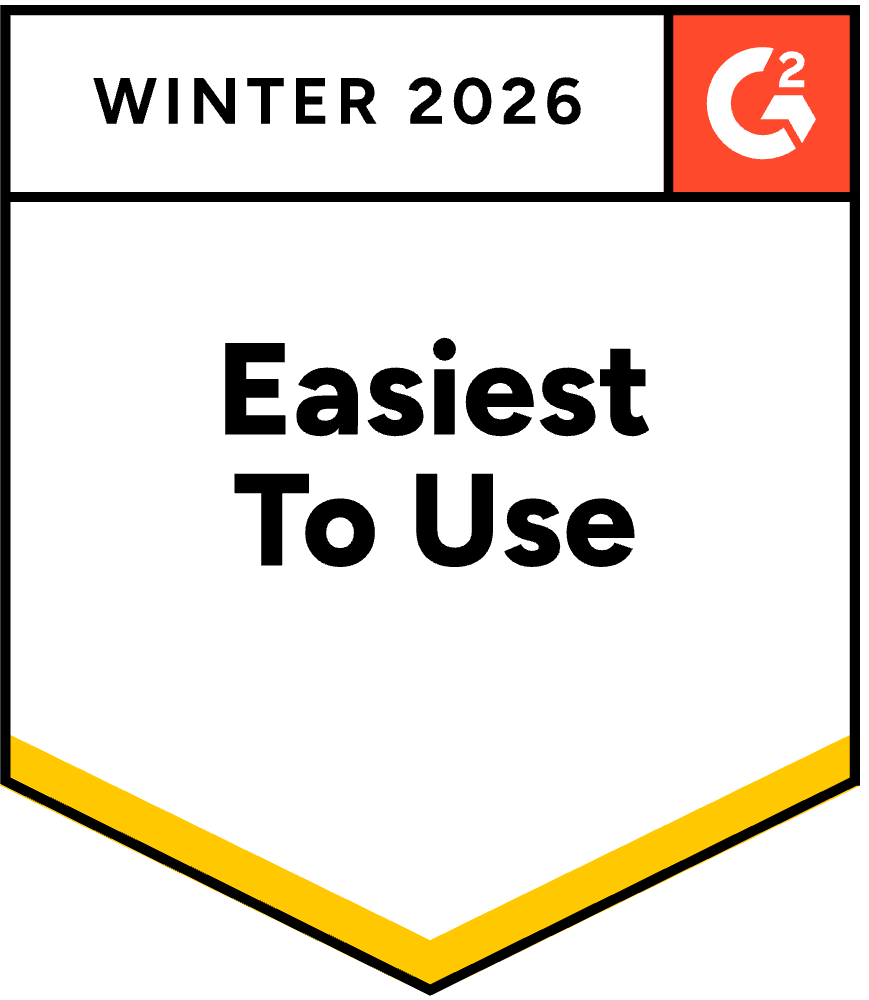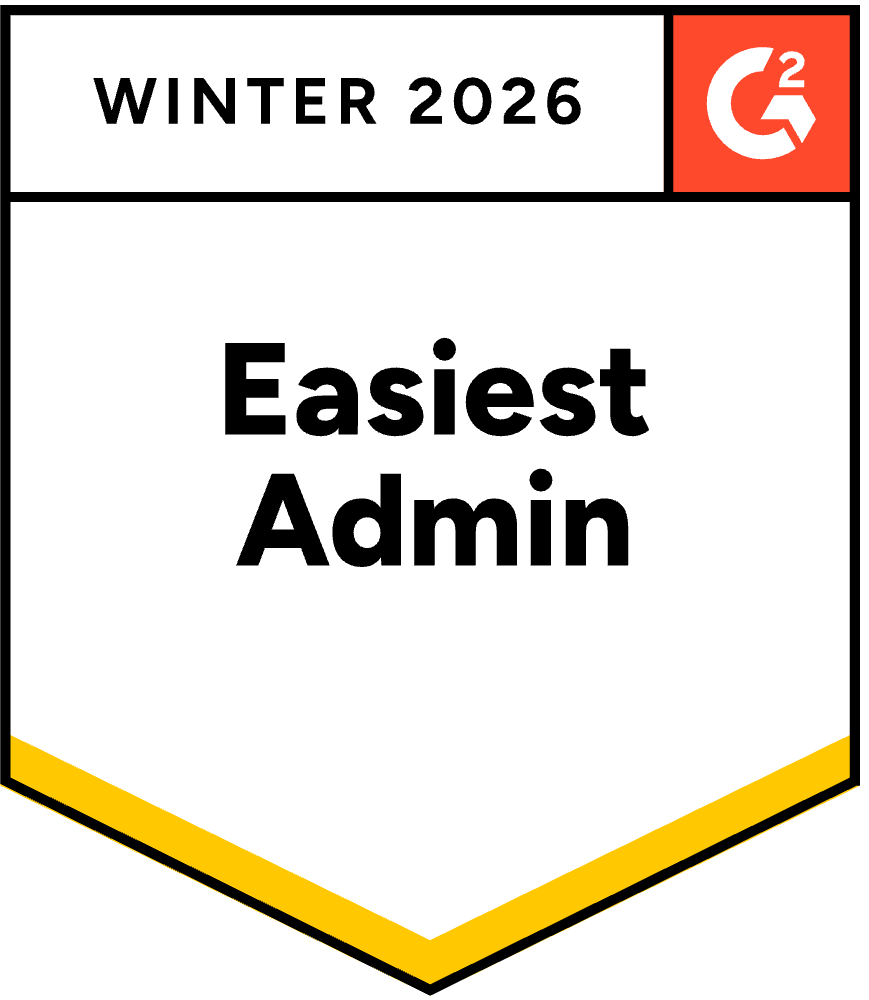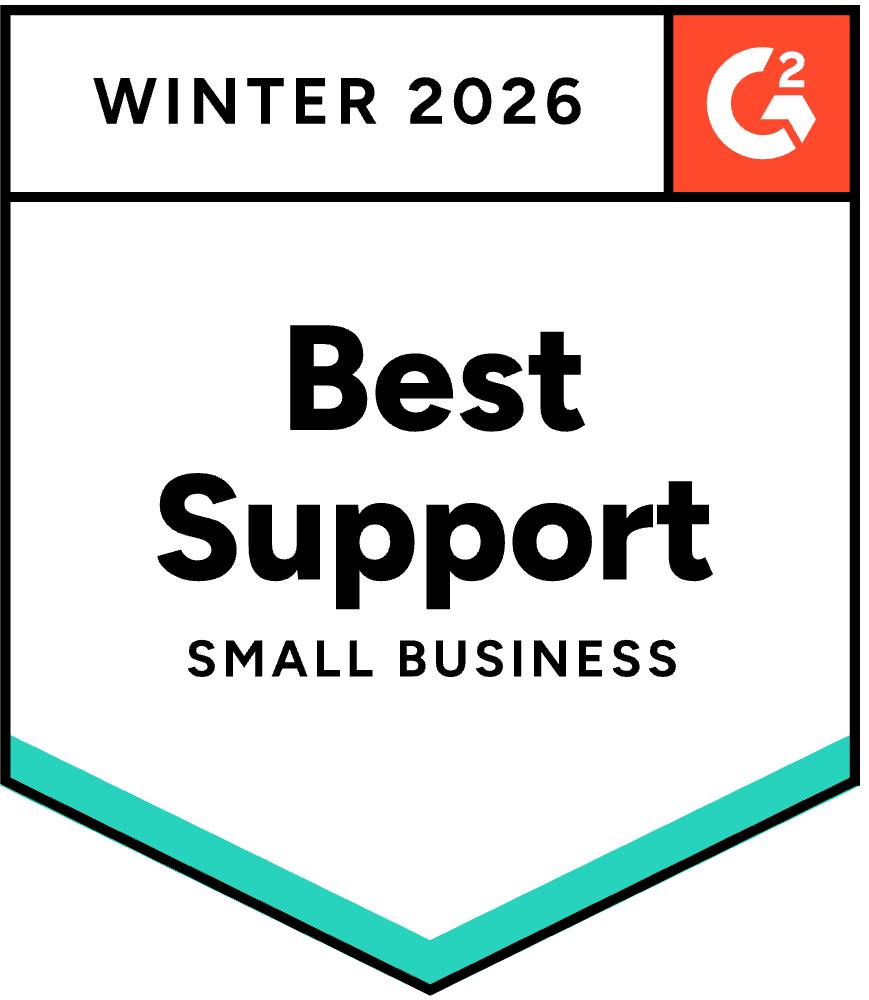Proposal Automation Software 2025: How to Automate Proposals
August 13, 2025
By
Evie Secilmis

Creating a winning proposal is a lot like cooking a gourmet meal. You wouldn't start from scratch for every single dish. The best chefs use mise en place—everything prepped, organized, and ready to go. Automated proposal software and proposal automation tools bring that same efficiency to your sales process. This proposal automation solution helps you organize your best content into a central library, ready at a moment's notice to automate proposals.
This article is your recipe book. We'll show you how to automate proposals by preparing your ingredients first, so you can consistently create high-quality, winning documents without starting over every time.
Key Takeaways
- Reclaim your team’s time for strategic work: Proposal automation and automated proposal software handle the repetitive tasks, like finding approved answers and formatting documents, so your experts can focus on personalizing the narrative and building the client relationships that actually win deals.
- Prepare your content before you automate: The success of your automation depends entirely on the quality of your inputs. Take the time to audit your existing documents, clean up your best answers, and organize them into a central library for consistent and accurate results.
- Combine automation with human oversight: Use automation to generate a strong first draft in minutes, but always have a person review it for quality, accuracy, and strategic tone. This human-in-the-loop approach gives you the speed of AI without losing the expert touch that closes deals.
What Exactly Is Proposal Automation and Automated Proposal Software?
If you’ve ever spent a weekend digging through old documents for the perfect answer to a security questionnaire, you already know the pain proposal automation solves.At its core, proposal automation and automated proposal software are about using smart proposal automation tools to handle the repetitive, time-consuming parts of creating business proposals and automate proposals efficiently.
Think of it as a system that helps you generate, manage, and send documents like RFPs, RFIs, and SOWs more efficiently. Instead of starting from scratch every time, you use a centralized content library and intelligent tools to build customized, accurate proposals in a fraction of the time. It’s less about cutting corners and more about working smarter, so your team can focus on what really matters: winning the deal.
Why Should You Use Proposal Automation and Automate Proposals?
The biggest reason to automate is to give your team back its most valuable resource: time. By letting software handle the tedious tasks—like finding approved answers, formatting documents, and filling in customer details you free up your experts to concentrate on more strategic work. This means they can spend more time tailoring the proposal's narrative, building a relationship with the client, or getting ahead on the next opportunity. Automation also dramatically improves accuracy and consistency. When everyone pulls from the same approved content library, you reduce the risk of human error and ensure every proposal that goes out the door is polished, professional, and on-brand. The benefits extend beyond just speed; they create a more streamlined and reliable sales process.
How Automation Beats Standard Tools like Word and Google Docs
We all love a good Google Doc. It’s familiar, easy to use, and great for drafting content. But when you’re managing multiple high-stakes proposals, relying on word processors is like trying to run a restaurant kitchen with just a microwave—it works for simple tasks, but it falls apart under pressure. The real difference comes down to process. With Word or Docs, you're stuck in a cycle of copy-pasting from old proposals, hunting for the latest approved answer, and wrestling with formatting inconsistencies. It’s a manual, error-prone system. Proposal automation software, on the other hand, acts as a central command center. It provides a single source of truth—a content library where all your best, most accurate information lives. This means you can generate a polished first draft in minutes, not hours, confident that you're using up-to-date information. Plus, you gain features that static documents just can't offer, like real-time tracking and seamless team collaboration.
How AI Helps You Write Proposals Faster
AI takes proposal automation to a whole new level. While basic automation can fill in templates, an AI-powered platform acts more like an intelligent assistant for your team. It can instantly search your entire content library to find the most relevant and up-to-date answers for any question in an RFP. More than that, AI can proactively identify information that might be outdated across your connected systems, ensuring your proposals are always accurate. It generates high-quality first drafts in minutes, not hours, giving your team a massive head start. This doesn't remove the need for human expertise; it enhances it. Your team provides the final polish, strategic oversight, and personalization that closes deals.
Clearing Up Common Misconceptions
Let’s clear up a common misconception: proposal automation is not here to make your job obsolete. The idea that software will completely replace the human element in proposal writing is simply not true. An automation tool is just that—a tool. It’s brilliant at handling repetitive, data-driven tasks, but it can’t replicate the critical thinking, creativity, and strategic insight that a person brings to the table. It can’t understand a client’s underlying needs or build genuine rapport. Instead of replacing you, automation empowers you. It takes the administrative burden off your shoulders so you can focus on crafting a compelling story and building a winning strategy, as many successful sales teams have discovered.
Is Proposal Automation Software and Automated Proposal Tools Right for Your Team?
Proposal automation isn't just for massive corporations.Any team that wants to spend less time on administrative work and more time on strategy can find value in proposal automation and automated proposal software. If you've ever felt like you're reinventing the wheel with every new RFP or that your best content is lost in a sea of old documents, automation is likely a good fit. It’s designed to give you back your time, improve the quality of your responses, and ultimately, help you win more deals.
The real question is, who sees the biggest impact? While the benefits of automation are broad, certain teams are perfectly positioned to see a dramatic return on their investment almost immediately. If your team is constantly up against tight deadlines, juggling complex requirements, or looking for a way to scale your services without burning out, you’re in the right place. Let's look at a few scenarios where proposal automation software goes from a helpful tool to an absolute game-changer.
If You're Sending a High Volume of Proposals
If your sales team feels more like a document factory than a group of strategic sellers, you’re a prime candidate for automation. When you’re churning out a high volume of proposals, RFPs, and SOWs, manual processes become a major bottleneck. Finding the right information, copying and pasting approved answers, and getting everything formatted correctly eats up hours that could be spent on client relationships.
Proposal automation software completely changes this dynamic. It speeds up turnaround times by cutting out the manual work, allowing for real-time collaboration, and instantly surfacing pre-approved content. Instead of starting from scratch, your team can generate a solid first draft in minutes, freeing them up to focus on tailoring the proposal to the client’s specific needs.
If You're Tackling Complex Bids and RFPs
Not all proposals are created equal. Bids for government contracts, healthcare, or finance often come with a mountain of complex requirements, security questionnaires, and strict compliance rules. One wrong answer or missed detail can get you disqualified before you even have a chance to make your case. This is where intelligent automation becomes a critical asset for your team.
By automating your business processes and streamlining workflows, you can create a more efficient and compliant response system. An AI-powered platform like Iris can help you manage DDQs and VSQs with precision, ensuring every response is accurate and up-to-date. This is especially crucial for teams pursuing opportunities like government contracts, where accuracy and adherence to protocol are non-negotiable.
Why Service-Based Businesses Need Automation
For agencies, consultants, and other service-based businesses, growth often means more proposals. But you can’t scale your client base if your team is buried in paperwork. Automation helps you break this cycle. By streamlining the proposal process, you can manage a much larger volume of leads and opportunities without overwhelming your team or sacrificing quality.
Think of it this way: the faster you can get a polished, professional, and personalized proposal into a prospect's hands, the better your chances of winning their business. Automation tools enable you to respond to opportunities quickly while maintaining brand consistency and accuracy. This efficiency allows you to pursue more leads and, as many businesses have found, significantly improve your win rate.
What to Look For in Automated Proposal Software
When you start comparing proposal automation tools, the number of features can feel overwhelming. Not all software is created equal, and the right choice depends on your team’s specific needs. To help you cut through the noise, focus on a few core capabilities that deliver the most impact. The best platforms blend powerful AI with practical tools that make your entire proposal process faster, smarter, and more consistent.
A Central Library for All Your Content
Think of this as your team’s single source of truth. Instead of hunting through old documents, shared drives, or chat messages for the perfect answer, a central content hub stores all your approved responses in one organized, searchable place. This ensures everyone on your team is using the most up-to-date and accurate information. When you can quickly find and reuse winning content, you not only save hours of work but also maintain a consistent voice across every proposal. Look for automated proposal software and proposal automation tools that make it simple to save, organize, and review your answers.
Smart, Customizable Templates
Starting every proposal from scratch is a huge time sink. Software with ready-to-use proposal templates gives you a solid foundation to build from, ensuring brand consistency and a professional look every time. You can create standard templates for different proposal types, like RFPs, SOWs, or security questionnaires. This speeds up the initial setup and lets your team focus on tailoring the content to the client instead of wrestling with formatting. It’s a simple feature that enforces quality control and helps you get proposals out the door much faster.
AI Assistance for Faster First Drafts
This is where modern proposal automation truly shines. The best tools use AI to generate complete first drafts in minutes, not hours. By analyzing the request and pulling from your content library, an AI-powered solution can assemble a relevant and comprehensive response. Of course, AI isn’t meant to replace your team’s expertise. A person should always review, customize, and fact-check the draft to add specific company details and match your brand’s tone. This human-in-the-loop approach gives you the perfect blend of speed and quality.
Seamless Integrations with Your Tech Stack
Your proposal software shouldn’t live on an island. To create a seamless workflow, it needs to connect with the other business tools you rely on every day, especially your CRM. Strong integrations with platforms like Salesforce or HubSpot prevent manual data entry errors and keep information consistent across your entire sales process. When your proposal tool can pull customer data directly from your CRM and update deal stages automatically, your team can work more efficiently and maintain a clear, accurate picture of your sales pipeline without switching between a dozen tabs.
Detailed Analytics and Proposal Tracking
Once you hit "send," the waiting game begins. But it doesn't have to be a black box. The best proposal software gives you detailed analytics, so you know exactly what happens after your document leaves your outbox. Instead of guessing, you can see who opened the proposal, which sections they spent the most time on, and what content they shared with their team. This isn't just about satisfying your curiosity; it's strategic intelligence. These insights into engagement patterns help you tailor your follow-up conversations. If you see they lingered on the pricing page, you can prepare to discuss budget. If they skipped over a key feature, you know where to focus your next call.
Built-in eSignatures and Payment Integrations
A great proposal gets the client excited to say "yes." The last thing you want is to slow that momentum with clunky next steps. Look for software that includes built-in eSignature capabilities, allowing clients to approve and sign the document right then and there. This eliminates the friction of downloading, printing, signing, and scanning. Some platforms take it a step further by integrating with payment gateways like Stripe or PayPal. This lets you turn your proposal into a direct sales tool, where a client can sign the contract and make the initial payment in one seamless action, as noted in this proposal software guide. It’s the fastest way to go from proposal to closed-won.
Collaboration Tools and User Roles
Proposal creation is rarely a solo effort. It often requires input from sales, legal, marketing, and subject matter experts. Without the right tools, this can turn into a chaotic mess of email threads and conflicting document versions. Effective proposal software brings everyone together in one workspace. It allows for real-time collaboration, so team members can leave comments, edit sections, and contribute their expertise simultaneously. Look for features like user roles and approval workflows, which let you control who can edit or approve content. This ensures that your technical experts can add their knowledge and your legal team can sign off on language, all within a structured and efficient process.
Top-Notch Security and Compliance
When you’re handling sensitive company and client information, security is non-negotiable. Any proposal automation software you consider must have robust security measures to protect your data. Look for platforms that are transparent about their security practices and hold certifications like SOC 2. This ensures they follow strict protocols for managing data, giving you peace of mind that your content is safe. Prioritizing a secure and compliant tool protects your business, builds trust with your clients, and prevents potentially costly data breaches down the line.
Getting Your Content Ready for Automation
Before you can let AI work its magic, you need to give it a solid foundation to build upon. Think of it like cooking: even the best chef needs quality ingredients. Great automation starts with well-organized, high-quality content. Taking the time to prepare your materials now will save you countless hours down the road and ensure your automated proposals are polished, accurate, and effective. This prep work involves auditing what you have, building a central library for your best responses, creating smart templates, and designing a workflow that makes sense for your team.
First, Audit and Organize Your Content
First things first, you need to know what you’re working with. Grab a whiteboard or open a new document and map out your current proposal process from start to finish. Note every step, from the initial request to the final submission. This exercise helps you spot the repetitive tasks and bottlenecks that are perfect candidates for automation. As you go, gather all your existing content—past proposals, case studies, security documents, and team bios. This is your chance to do some spring cleaning. Ditch the outdated statistics, refresh tired messaging, and ensure everything aligns with your current brand voice.
Next, Build Your Central Response Library
Once you’ve audited your content, it’s time to build your response library. This isn't just a messy folder of old RFPs; it's a centralized, single source of truth for every possible question you might encounter. This library should house your best, most up-to-date answers, ready to be pulled into any proposal. When you have a central hub for your content, your team can respond to bids with confidence, knowing they’re using approved and accurate information. An AI-powered system can even help you manage this library by proactively identifying content that needs a refresh, ensuring your responses are always current.
Then, Create Your Master Templates
Templates are the backbone of efficient proposal automation. Instead of starting from scratch every time, you can create master templates for different situations, like RFPs, RFIs, or SOWs. These templates provide a consistent structure, ensuring every proposal that leaves your office looks professional and reflects your brand. You can pre-load them with your company branding, standard legal disclaimers, and section layouts. This way, the AI has a clear framework to follow, and all it needs to do is populate the template with personalized content from your response library, dramatically speeding up the process.
Finally, Map Out Your Ideal Workflow
With your content organized and your templates ready, the final step is to design your ideal workflow. Think about how a proposal should move through your organization. For example, you can set up a system that automatically sends a first draft to the sales lead for review, then routes it to the legal team for approval before it goes to the client. Mapping this out helps eliminate manual hand-offs and keeps the process moving. Using a tool with real-time tracking gives you visibility into where every proposal is in the pipeline, allowing you to spot and resolve any issues quickly. This streamlined process is key to improving your deal volume and win rates.
How to Build Your First Automated Proposal
With your content organized and your workflow mapped out, you’re ready for the exciting part: building your first automated proposal. This is where your preparation pays off, turning a manual, time-consuming task into a streamlined process. Think of this as creating a smart, reusable system that does the heavy lifting for you. The goal isn’t to remove your expertise but to channel it more efficiently, letting you focus on strategy and personalization instead of copy-pasting. Let’s walk through the four key steps to assemble your first automated proposal.
Step 1: Set Up Your Base Templates
Your first step is to create base templates for your most common proposals, like RFPs, SOWs, or security questionnaires. These aren’t just static documents; they are the foundational skeletons of your future responses. Proposal automation software uses these ready-made templates to give you a massive head start. You can design them with your branding, standard legal disclaimers, and core sections like "About Us" and "Our Approach." By having these core components pre-approved and in place, you ensure consistency and dramatically reduce the time it takes to generate a first draft for any new opportunity.
Step 2: Add Dynamic Fields to Personalize
An automated proposal should never feel robotic. This is where dynamic fields come in. Think of them as smart placeholders in your template that automatically pull in client-specific information. When you start a new proposal, the software can populate fields for the client’s name, company, project details, and any other custom data you’ve stored in your CRM. This simple step instantly makes the proposal feel personal and tailored to the recipient. It ensures you get the details right every time without manually typing them, freeing you up to focus on the strategic parts of the response.
Step 3: Use Smart Rules and Conditional Logic
Here’s where the real magic happens. You can implement smart rules to automatically add or remove entire content blocks based on the opportunity. Think of it like setting up "triggers and actions." For example, you can create a rule that says, "If the client is in the financial services industry, automatically insert the 'Data Security & Compliance' section." Or, "If the proposal value is over $100,000, include the 'Enterprise Case Studies' section." This conditional logic ensures every proposal is perfectly relevant to the client's needs without you having to remember to add each specific piece of content yourself. It’s a powerful way to customize responses at scale.
Step 4: Always Review for Quality and Accuracy
While automation is a powerful assistant, it’s not a replacement for your team's critical eye. The final step before sending any proposal is a thorough human review. Automation tools are designed to produce a high-quality first draft with incredible speed, but human oversight is essential for catching nuances, confirming strategic alignment, and adding that final layer of polish. Use the time you save on assembly to carefully review the generated document for quality and accuracy. This ensures your proposal is not only fast and relevant but also compelling and error-free, which is key to improving your win rates.
Personalizing Proposals at Scale (Without Losing Your Mind)
Automating your proposal process doesn't mean sending out generic, one-size-fits-all documents. In fact, it’s the opposite. The right automation strategy allows you to personalize your proposals more effectively and consistently than you ever could manually. It’s about using technology to handle the repetitive tasks so your team can focus on the strategic elements that make a proposal resonate with a client.
When you customize at scale, you make every potential client feel like they’re your only priority. You can speak directly to their specific pain points, reference their industry, and present solutions that feel tailor-made, all without starting from scratch each time. This level of personalization builds trust and shows the client you’ve done your homework. By setting up your automation software correctly, you can deliver this bespoke experience quickly and efficiently, giving you a significant advantage over the competition.
Swap Content Instantly with Dynamic Blocks
Think of dynamic content blocks as your personal library of pre-approved, high-impact proposal sections. Instead of manually searching for the right case study or service description for each new bid, you can use an AI-powered platform to do it for you. You can tag content by industry, company size, specific pain points, or any other variable that matters to your sales process. When you generate a new proposal, the software intelligently pulls in the most relevant content blocks based on the client’s information. This ensures every proposal is perfectly tailored with your best, most persuasive content, turning a time-consuming task into a simple, automated step.
Keep Everything On-Brand, Automatically
One of the biggest challenges of managing a high volume of proposals is keeping everything on-brand. When different team members are creating documents, it’s easy for formatting, logos, and even tone of voice to become inconsistent. Proposal automation solves this problem by establishing a single source of truth. By using master templates, you guarantee that every proposal that goes out the door adheres to your company’s brand guidelines. This creates a clear, repeatable process that not only looks professional but also eliminates the risk of embarrassing errors. You can finally stop policing fonts and colors and focus on the quality of your answers.
Create Error-Free Pricing Tables in Seconds
Manually creating pricing tables for each proposal is not only tedious but also risky. A simple copy-paste error or a miscalculation can jeopardize a deal or hurt your profit margins. Automation removes this risk by connecting directly to your product and service information. You can set up rules to automatically calculate costs, apply standard discounts, and generate accurate, professional-looking pricing tables tailored to each client’s specific needs. This feature saves an incredible amount of time and ensures your pricing is always consistent and error-free, letting your team build complex quotes with confidence.
Make Your Pricing Interactive
Let's take this a step further. Instead of just a static table, what if you could let your clients build their own solution right inside the proposal? That's the idea behind interactive pricing. You can include options, add-ons, and different service tiers that clients can select or deselect, turning your proposal from a flat document into a collaborative tool. This approach gives the buyer a sense of control and helps them see the direct impact of their choices on the final price. It can significantly reduce the back-and-forth negotiation, as clients can adjust the scope to fit their budget on their own time. This is a core benefit of modern configure, price, quote (CPQ) tools, and it gives you valuable insight into what features they value most.
Don't Forget the All-Important Human Touch
Proposal automation tools are designed to work with you, not replace you. Their purpose is to handle the heavy lifting so you can apply your expertise where it matters most. While an AI platform like Iris can generate a high-quality first draft in minutes, the final review is where your team’s insight becomes invaluable. This is your chance to add a personal note to the executive summary, tweak a sentence to perfectly match the client’s tone, or add a final thought that shows you were truly listening. Automation gets you 90% of the way there, but that final 10% of human touch is what builds relationships and ultimately wins deals.
Advanced Automation Tips and Tricks
Once you’ve mastered the basics of automating your proposals, you can start exploring more advanced features that truly transform your sales process. Moving beyond simple template-filling, this next stage is about creating a smarter, more connected workflow. It’s where you can handle greater complexity with ease, expand your reach into new markets, and streamline internal operations that used to be major bottlenecks. These capabilities are what separate a good proposal process from a great one, allowing your team to operate with more precision, speed, and strategic insight. By leveraging these advanced functions, you’re not just saving time on individual proposals; you’re building a scalable engine for growth that supports your team at every turn.
Going Global? Support Multiple Languages
If your business has global ambitions, language should never be a barrier to a great opportunity. Advanced proposal automation tools can help you cater to diverse client bases by supporting multiple languages. This means you can generate proposals in a client’s native language without having to manually translate every document. It’s a powerful way to show respect and understanding, making your company stand out in a competitive international market. Instead of seeing a foreign RFP as a hurdle, your team can see it as just another opportunity to win. This feature allows you to confidently pursue deals around the world, knowing your proposals will be clear, professional, and perfectly tailored to the audience.
How to Handle Complex Pricing Scenarios
Manually creating pricing tables can be tedious and prone to error, especially when dealing with multiple products, tiered discounts, or variable service rates. A small mistake can undermine client trust or hurt your margins. Proposal automation lets you handle complex pricing scenarios flawlessly by automatically calculating costs and generating accurate tables. You can set up rules based on the products or services selected, and the software does the heavy lifting. This ensures every quote is precise, professional, and consistent. It frees up your sales team from wrestling with spreadsheets so they can focus on communicating value, not just crunching numbers.
Create a Faster, Smarter Approval Process
We’ve all felt the pain of a proposal getting stuck in limbo, waiting for review from legal, finance, or management. These internal delays can jeopardize a deal. Automation helps you streamline your approval process by creating a clear, digital path for every proposal. You can set up rules that automatically route the document to the right stakeholders in the correct order. Team members are notified when it’s their turn to review, and they can leave comments or approve directly within the platform. This transparency eliminates bottlenecks and ensures everyone provides their input efficiently, getting your winning proposal out the door faster.
Connect Your Proposal Software to Your CRM
Your CRM is the heart of your sales operations, and your proposal tool should be its right hand. The best automation platforms integrate directly with your CRM and other essential business systems. This connection allows you to pull customer data, contact information, and deal details directly into your proposal, eliminating repetitive data entry and reducing the risk of errors. Once the proposal is sent, its status can be automatically updated in the CRM, giving your entire team a clear view of the sales pipeline. This creates a seamless flow of information, ensuring your data is always consistent, up-to-date, and accessible right where you need it.
How to Ensure Long-Term Success with Automation
Adopting proposal automation is a major step forward, but it’s not a one-and-done task. To get the most out of your investment, you need to treat it like any other critical business system: with ongoing attention and refinement. Think of it as tending to a garden; the initial planting is just the beginning. Consistent care is what ensures a great harvest. By establishing a few key habits, you can make sure your automation software continues to deliver value, streamline your workflow, and help your team win more deals for years to come.
Putting the right platform in place is the first step, but long-term success comes from how you manage it. This means keeping your content library pristine, ensuring your team feels confident using the tool, prioritizing the security of your data, and constantly measuring your results to find new ways to improve. These practices will transform your proposal software from a helpful tool into an indispensable part of your sales engine, giving you a durable competitive advantage.
Regularly Update and Refresh Your Content
Your automated proposals are only as good as the information they’re built on. An outdated content library can lead to inaccurate or irrelevant proposals, which is the fastest way to lose a potential client’s trust. Make it a habit to regularly review and refresh your response library. Your automation software can help by flagging duplicate or aging content, but it’s up to your team to decide what to update, merge, or remove.
Schedule a quarterly content audit to update statistics, add new case studies, and refine product descriptions. This ensures every proposal that goes out the door is sharp, accurate, and reflects the very best of what your company offers. Modern AI-powered features can significantly speed up this process, but the strategic oversight of a human expert is what keeps the content truly effective.
Get Your Whole Team On Board
The most powerful software in the world is useless if your team doesn’t know how—or why—to use it. Smooth adoption starts before you even implement a tool. A great first step is to map out your current proposal process from start to finish. This exercise helps you identify the most repetitive and time-consuming steps that are perfect candidates for automation, building a clear case for the new software.
Once the tool is in place, focus on comprehensive training that goes beyond a single demo. Show your team how it directly solves their biggest pain points, like spending hours searching for the right answer or manually formatting documents. When your team sees the tool as a way to make their jobs easier and more successful, you’ll see much faster and more successful adoption.
Extend the Benefits Beyond the Sales Team
While the sales team might be the primary driver, the positive impact of proposal automation is felt across the entire company. Think about it: creating a winning proposal is rarely a solo effort. It often requires input from legal, marketing, finance, and subject matter experts. Automation transforms this collaboration from a chaotic scramble into a streamlined process. Instead of constantly pinging your experts for the same security details or product specs, they can contribute their approved knowledge to a central library. This means their expertise is captured accurately and reused efficiently, while automation handles the repetitive tasks. This frees them up to focus on their strategic work, reduces the risk of inconsistent information, and ensures every department is aligned.
Make Data Security a Top Priority
Proposals are filled with sensitive information, from your company’s strategic pricing to your client’s confidential project details. Protecting that data is not just a best practice; it’s a requirement for building and maintaining trust. When choosing an automation platform, security should be at the top of your checklist. Look for tools that offer robust security protocols, such as data encryption, granular user permissions, and compliance with recognized standards like SOC 2.
These features ensure that only the right people can access and edit sensitive content, protecting both your intellectual property and your clients' data. A secure platform gives you and your clients peace of mind, reinforcing your reputation as a trustworthy and professional partner.
Track Your Performance and Find Wins
One of the greatest advantages of proposal automation is the wealth of data it provides. Don’t let it go to waste. Use the analytics within your platform to get a clear view of your proposal process in real time. This allows you to spot bottlenecks, understand what’s working, and make data-driven decisions to refine your strategy.
Track key performance metrics like how long it takes to generate a first draft, which pieces of content are used most frequently, and, of course, your proposal win rate. If you notice a certain template is performing exceptionally well, dig in to understand why and apply those learnings elsewhere. This cycle of monitoring, analyzing, and optimizing is what drives continuous improvement and ensures you’re always putting your best foot forward.
How to Measure the ROI of Your Proposal Software
Bringing automation into your proposal process is a huge step, but it’s not a one-and-done fix. Think of it as planting a garden—you don’t just toss the seeds in and walk away. You have to water, weed, and make sure it’s getting enough sun. Similarly, to get the most value from your automation software, you need to measure its impact and look for ways to make it even better. This is where you turn a good process into a great one that consistently delivers results.
The goal is to create a feedback loop. You use the tool, gather data on how it’s performing, and then use those insights to refine your strategy. Are you saving as much time as you hoped? Are your win rates improving? Is your content library actually making things easier? Answering these questions helps you prove the ROI of your investment and ensures your team is using the software to its full potential. By regularly checking in on your performance, you can make small adjustments that lead to big wins over time, ensuring your automated system evolves with your business needs.
What KPIs Should You Be Tracking?
Before you can improve anything, you need to know what you’re measuring. Don’t get overwhelmed by all the data your new tool provides. Instead, focus on a few key performance indicators (KPIs) that directly reflect your goals. These might include proposal turnaround time, the number of proposals your team can handle per month, or even content accuracy scores. Automation tools are great at collecting data, but it’s the human touch that provides context. Your team should regularly review this data to ensure the information is correct and decide how often your content needs a refresh. This keeps your automated system sharp and your proposals relevant.
Analyze Your Proposal Win/Loss Rates
The ultimate measure of success is your win rate. Are you closing more deals? Automation helps your team manage a larger volume of proposals without getting bogged down, which naturally creates more opportunities to win. Take a look at your win rate before and after implementing an automation tool to see the difference. It’s also incredibly valuable to analyze the deals you didn’t win. Were there common themes in the feedback? This information can help you identify weak spots in your content library or templates, allowing you to make targeted improvements. Many teams have seen their win rates climb after adopting a more streamlined, AI-driven approach.
Calculate How Much Time You're Saving
One of the most immediate benefits of proposal automation is getting time back in your day. Manually assembling proposals is a drain on resources, pulling your team away from more strategic work. Start tracking how long it takes to create a proposal from start to finish. Compare your manual process to your new automated one. The difference is often staggering. Automation speeds up turnaround by cutting out repetitive tasks and surfacing pre-approved content instantly. Quantifying this time savings is a powerful way to demonstrate the value of your tool and justify the investment to leadership. It’s not just about working faster; it’s about freeing up your team to focus on what matters most.
By the Numbers: What the Data Says
The benefits of proposal automation aren't just theoretical; the numbers tell a compelling story. The most dramatic impact is on time. Teams that adopt automation see a massive reduction in the hours spent on manual document creation, with some companies reporting as much as a 95% drop in the time they spent making documents. This isn't just about working faster; it's about working smarter. When you can create proposals in 17 minutes or less, your team can handle a higher volume of opportunities without burning out. This efficiency translates directly to better outcomes, with some businesses seeing their sales close rate double compared to the average. It all starts with getting a strong first draft quickly, and with AI, you can generate high-quality drafts in minutes, giving your team a huge head start on the path to winning.
Always Look for Ways to Optimize
Your automation system should grow with you. The best way to ensure this happens is to regularly look for ways to optimize your process. While AI can do the heavy lifting of parsing long RFPs and suggesting responses, a person should always review the output to ensure it’s complete and accurate. Schedule quarterly check-ins to review your master templates, your response library, and your overall workflow. Are there bottlenecks? Is some content becoming outdated? By treating your automation platform as a dynamic tool rather than a static one, you’ll continuously refine your approach and improve the quality of every proposal you send.
How to Choose the Right Automated Proposal Software
Choosing the right automation tool can feel like a big decision, but it really comes down to what your team needs most. The market is filled with options, from simple template-based software to sophisticated AI engines. The best choice for you will depend on your proposal volume, the complexity of your bids, and the systems you already use.
Think about your biggest bottleneck. Is it finding the right answers quickly? Is it ensuring brand consistency across every document? Or is it just the sheer time it takes to assemble a proposal from scratch? Understanding your primary challenge will help you zero in on the platform that will make the biggest impact on your workflow and, ultimately, your win rate. Let’s look at the main categories of tools you’ll find.
For an All-in-One AI Proposal Generator
If your team handles a high volume of proposals or responds to complex RFPs, an AI-powered platform is likely your best bet. These tools go far beyond basic templates. They use technology to handle major parts of the proposal process with less human effort, helping you write, format, and manage your content. An intelligent AI deal desk can instantly generate accurate first drafts by pulling from a central library of your best-approved answers, saving your team from starting from a blank page every time. This is the solution for teams that need to move fast without sacrificing quality or accuracy on detailed bids.
For Basic Templating and Content Storage
For teams with more straightforward sales documents, a simple template-based tool can be a great entry point into automation. This type of software helps you create custom proposals quickly by starting with ready-made templates and plugging in specific information for each client. The main benefit here is speed and consistency for less complex documents. While these tools are excellent for standardizing your look and feel, they generally don't offer the same level of AI-driven content generation or management you’d find in a more advanced platform. They are a solid choice if your proposals don't vary much from client to client.
For Deep Integration with Your Existing Tools
No tool is an island, and your proposal software shouldn't be either. The most powerful solutions are those that connect with the other business tools you rely on daily, especially your CRM. When your proposal software integrates with systems like Salesforce or HubSpot, you can pull customer data directly into your documents, eliminating manual entry and reducing the risk of errors. This ensures information stays consistent from the first touchpoint to the final signature. A strong integration ecosystem means a smoother workflow for your team and a more professional, error-free experience for your clients.
Comparing Popular Proposal Software Tools
The proposal software market is packed with options, each with its own strengths. To find the right fit, it helps to group them by what they do best. Some are built around powerful AI engines designed to automate complex responses, while others focus on creating beautiful, interactive documents. There are also all-in-one platforms that handle everything from creation to e-signature, and simpler tools perfect for freelancers or small teams just getting started. Let's break down some of the most popular players in each category so you can see how they stack up.
For AI-Powered Response Automation: HeyIris.ai, Responsive, & Loopio
If your main goal is to cut down the time it takes to answer complex RFPs and security questionnaires, an AI-powered tool is what you need. Platforms like Responsive (formerly RFPIO) and Loopio are strong contenders, using AI to help you search your content library and reuse existing answers. But for a solution that acts as a true intelligent assistant, there's Iris. Instead of just finding old content, our platform proactively searches your entire knowledge base to surface the most relevant, up-to-date information, helping you generate a highly accurate first draft in minutes. This approach is ideal for teams that need to respond to detailed, high-stakes bids with speed and precision.
For All-in-One Platforms: PandaDoc & Proposify
If you're looking for a single tool to manage your entire proposal lifecycle, all-in-one platforms are a great choice. Tools like PandaDoc and Proposify are designed to help you create, send, track, and get e-signatures on your sales documents. They offer a streamlined workflow that covers everything from building a proposal with pre-made templates to seeing when a client opens it. These platforms are excellent for sales teams that want to standardize their process, improve document tracking, and close deals faster without juggling multiple different tools for design, delivery, and signing.
For Interactive and Design-Focused Tools: Qwilr
Sometimes, a standard PDF just doesn’t cut it. If you want your proposals to stand out and engage your clients, a design-focused tool like Qwilr is worth a look. It transforms your proposals from static documents into interactive web pages. You can embed videos, add ROI calculators, and include booking calendars directly within the proposal. This creates a much more dynamic and engaging experience for the client, allowing them to interact with your content instead of just reading it. It’s a fantastic option for creative agencies or any business that wants to make a strong visual impact.
For Freelancers and Small Teams: Bonsai, Nusii, & Jotform
You don't need a massive budget or a huge team to benefit from proposal software. There are plenty of great options designed specifically for freelancers and small businesses. Bonsai is a popular choice because it combines proposals with other essential freelance tools like contracts, invoicing, and project management. If you work with clients around the world, Nusii is a great option that supports multiple languages and currencies. And if you're just starting out and need a simple, no-cost solution, Jotform offers a free plan for creating basic proposals.
Understanding Common Pricing Models
Pricing for proposal software can vary quite a bit, so it’s important to understand what you’re paying for. Most tools operate on a subscription model, typically charging per user, per month. Basic plans might start around $25 per user and are great for individuals or small teams with simple needs. More advanced plans, which often include AI features, deeper integrations, and more robust analytics, can range from $49 to well over $100 per user. When comparing options, look beyond the sticker price and consider what’s included. Some platforms may limit the number of active proposals you can have at one time, so be sure the plan you choose aligns with your team’s volume.
Don't Forget to Try Before You Buy
Reading reviews is helpful, but there’s no substitute for hands-on experience. Nearly every proposal software tool offers a free trial or a live demo, and you should absolutely take advantage of it. This is your chance to see if the interface feels intuitive to your team and if the workflow fits your current process. Use the trial period to build a real proposal and test out the features that matter most to you, like CRM integrations or content library management. For more advanced AI platforms, scheduling a demo is often the best way to see the full power of the tool in action and ask specific questions about how it can solve your team’s unique challenges.
Related Articles
- Automated Proposals: Respond in Half the Time
- Why Most Proposal Automation Software Isn’t Actually Automated
- Mastering RFP Responses with AI Efficiency
- AI RFP Automation for Enterprise Sales
Frequently Asked Questions
Will proposal automation make my proposals sound robotic and impersonal? Not at all—in fact, it should do the exact opposite. The goal of automation isn't to remove your voice, but to handle the tedious parts of the process so you have more time to infuse your expertise and personality. By using software to pull approved product details and answer standard questions, you free up your energy to write a compelling executive summary or add a personal note that speaks directly to the client's needs. Think of it as a tool that gets you 90% of the way there, so you can focus on the final 10% that actually builds relationships and wins the deal.
How much work is it to get started with proposal automation? The initial setup is the most important part, but it's more about being thoughtful than it is about being difficult. The main task is gathering your best content—your strongest case studies, most accurate security answers, and clearest product descriptions—and organizing it into a central library. While this takes some upfront effort, a good platform makes the process straightforward. Once your core content is in place, the time savings on every single proposal you create from then on will more than pay back your initial investment.
Is this kind of software only for large enterprise teams? Absolutely not. While large teams handling a high volume of complex RFPs see a huge return, any business that wants to be more efficient can benefit. If you're a smaller team or even a solo consultant, automation helps you punch above your weight. It allows you to respond to opportunities faster, maintain a professional and consistent brand image, and manage more proposals without burning out or needing to hire more people. It’s about scaling your ability to win, no matter the size of your team.
My current proposal content is a mess. Do I need to have it perfectly organized before I start? You don't need perfection, you just need a starting point. The process of adopting an automation tool is actually the perfect opportunity to do some spring cleaning on your content. Most teams start by identifying their top 20-30 most frequently used responses and building their library from there. A great platform will even help you spot duplicate or outdated information as you go. It's better to start with a small, high-quality library and build on it over time than to wait until you have every possible answer perfectly polished.
What’s the real difference between a basic template tool and an AI-powered platform? Think of it this way: a basic template tool is like a fill-in-the-blanks worksheet. It gives you a consistent structure and look, but you still have to manually find and insert all the relevant content yourself. An AI-powered platform is more like an intelligent assistant. It can read a request, understand the questions being asked, and then search your entire content library to generate a complete and accurate first draft for you. It does the heavy lifting of assembly, not just formatting.
Share this post
Link copied!



